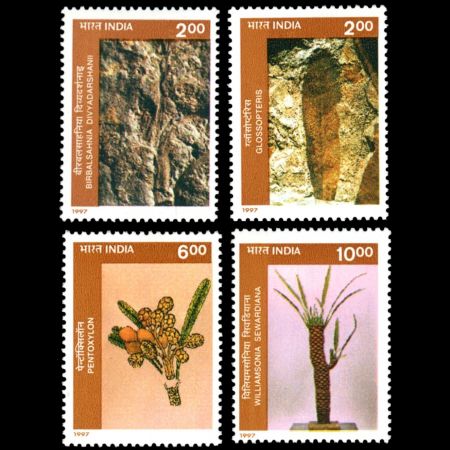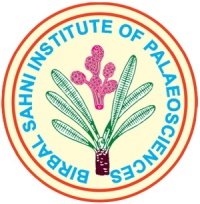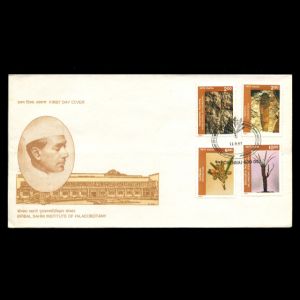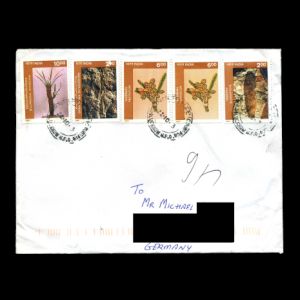India 1997 "Birbal Sahni Institute of Palaeobotany, Lucknow"
| << prev | back to index | next >> |
| Issue Date | 01.09.1997 |
| ID | Michel: 1568-1571; Scott: 1622-1625; Stanley Gibbons: 1732-1735; Yvert et Tellier: 1338-1341; Category: pF |
| Design | Uttar Pradesh |
| Stamps in set | 4 |
| Value |
2 - Birbalsahnia divyadarshanii 2 - Glossopteris 6 - Pentoxylon 10 - Williamsonia sewardiana |
| Emission/Type | commemorative |
| Places of issue | |
| Size (width x height) | 29mm x 39.1mm |
| Layout | Sheets of 35 stamps |
| Products | FDC x 1 |
| Paper | Gravured coated stamp paper |
| Perforation | 13,25 x 13,50 |
| Print Technique | Photogravure |
| Printed by | Security Printing Press, Nashik |
| Quantity | 400.000 |
| Issuing Authority | Indian Post |

On September 11th, 1997, the Post Department of Advertising and Visual Publicity Ministry of Information and Broadcasting of Government of India, issued the set "Birbal Sahni Institute of Palaeobotany, Lucknow". The stamps set was issued on the occasion of 50th anniversary of the Institute. Two stamps of the set show fossils and another two reconstructions of some prehistoric plants. The cachet of the FDC show the building of the Institute and portrait of its founder - Professor Birbal Sahni.
Palaeobotany is the study of plant fossils preserved in rocks. The word "Fossil" has been defined as "any evidence of prehistoric life". Plant fossils were formed by burial and preservation in the sediments in the geological past. During transport to the site of burial the plant parts underwent decomposition and deformation to varying degrees. The environment of the depositional site controls the preservation of these plant remains. Research in the science of palaeobotany deals with both large and miniature plant fossils as they help to deduce the antiquity, radiation and evolutionary pattern of life on earth, the vegetation which was responsible for coal/oil reserves on earth, environment and climate of the past and correlation of sedimentary sequences.
 |
| Professor Birbal Sahni on the cachet of the First Day Cover (FDC) of India 1997 |
 |
| Logo of The Birbal Sahni Institute of Palaeosciences |

|
| German scholar Albertus Magnus on stamp of Germany (BRD/FRG) from 1980, MiNr.: 1049, Scott: 1328. |
Professor Birbal Sahni (1891 – 1949) was the first Indian to revitalize study of Indian fossil plants.
He was a visionary in that he saw the potential of palaeobotanical research in India in understanding plant evolution through the ages and application of this knowledge for human welfare.
His major contributions were in the study of the fossil plants of India and in plant evolution.
In 1921 he was appointed the first Professor and Head of the Botany Department of the Lucknow University, a position he retained until his death.
Based on the ecology of plants and the altitude of the fossil finds, he attempted to estimate rates of uplift of the Himalayas. It was through Prof. Sahni's efforts and zeal that the Institute of Palaeobotany in Lucknow was founded in September 1946. The Institute functions as an autonomous research organization under the Department of Science and Technology, Government of India, to develop scientific knowledge and expertise in all branches of palaeobotany and related disciplines.
The initial office of the Institute was at the Department of Botany, Lucknow University. Later on, it moved to its own building in Lucknow and was renamed to the Birbal Sahni Institute of Palaeosciences (BSIP).
The goal of BSIP is solving issues of origin and evolution of plant life, other geological issues including exploration of fossil fuels. Originally plant fossil and related studies based, the mandate of the BSIP was recently expanded to combine it with other areas of palaeosciences, and creating modern facilities to achieve this end.
Some fossils and reconstruction of prehistoric plants from the collection of the Birbal Sahni Institute of Palaeosciences formerly Birbal Sahni Institute of Palaeobotany. are shown on the following stamps.
 |
| Reconstruction of Pentoxylon on stamp of India 1997, MiNr.: 1570, Scott: 1624. |
 |
| Reconstruction of Williamsonia sewardiana on stamp of India 1997 MiNr.: 1571, Scott: 1625. |
Pentoxylon takes its name from the five wedges of wood that characterize its stem. Pentoxylon is a Gondwanan taxon, which has been found in India, Australia and New Zealand. Pentoxylon first appears in the later part of the Paleozoic, but its greatest diversity and abundance appears to be in the Jurassic, continuing into the Early Cretaceous.
Williamsonia sewardiana - extinct genus of plant belonging to the Bennettitales, an order of seed plants which bore a resemblance to cycads.
A model of the extinct plant Williamsonia sewardiana which thrived in Rajmahal, Bihar about 140 million years ago. This model is based on the reconstruction envisaged by Prof. Birbal Sahni. Originally described as Zamia gigas by William Crawford Williamson. William Carruthers proposed the name Williamsonia in an 1870 paper of his, with the type species being Williamsonia sewardiana.
Fossils of specimens of Williamsonia have been discovered worldwide.
 |
| Fossil of Birbalsahnia divyadarshanii on stamp of India 1997, MiNr.: 1568, Scott: 1622. |
 |
| Fossil of Glossopteris on stamp of India 1997, MiNr.: 1569, Scott: 1623. |
Glossopteris- the tongue-shaped leaf Glossopteris, represents a unique group of extinct vascular plants (age: Permian, 250-280 million years). During this period India occupied a position south of equator close to South Pole as a part of a very large continent which included South America, Antarctica, Africa and Australia, called Gondwana. This vegetation was responsible for the precious coal reserves in peninsular India.
Products and associated philatelic items
| FDC | Example of circulated covers | |
 |
 |
|
| The reverse side is here | The cover sent to Germany from Lucknow city in 2013 |
References

|
- Technical details and official press release:
Brochure of Indian Post, Colnect, India Picks. - Palaeobotany:
Wikipedia, Encyclopedia Britannica, - Birbal Sahni:
Wikipedia, International Organisation of Paleobotany, - The institute:
official website, Wikipedia, - Williamsonia:
Wikipedia,
Acknowledgements
Many thanks to Dr. Peter Voice from Department of Geological and Environmental Sciences, Western Michigan University, for reviewing the draft page and his valuable comments.| << prev | back to index | next >> |